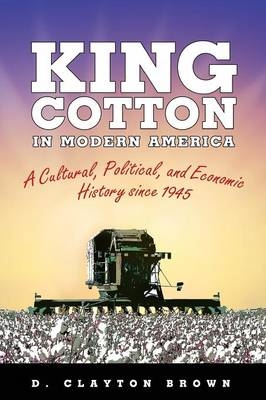
King Cotton in Modern America
A Cultural, Political, and Economic History since 1945
Seiten
2013
University Press of Mississippi (Verlag)
978-1-61703-835-8 (ISBN)
University Press of Mississippi (Verlag)
978-1-61703-835-8 (ISBN)
Places the once preeminent southern crop in historical perspective, showing how “cotton culture” was actually part of the larger culture of the United States despite the widespread perception of its cultivation and sources as hopelessly backward.
King Cotton in Modern America places the once preeminent southern crop in historical perspective, showing how ""cotton culture"" was actually part of the larger culture of the United States despite the widespread perception of its cultivation and sources as hopelessly backward. Leaders in the industry, acting through the National Cotton Council, organized their various and often conflicting segments to make the commodity a viable part of the greater American economy. The industry faced new challenges, particularly the rise of foreign competition in production and the increase of man-made fibers in the consumer market.
Modernization and efficiency became key elements for cotton planters. The proliferation of cotton fields in the western states after 1945 enabled America to compete in the world cotton market, but internal dissension developed between the traditional regions of the South and the new areas in the West, particularly over the USDA cotton allotment program. Mechanization had profound social and economic impacts.
Combining history with music and literature, D. Clayton Brown carries cotton's story to the present with a special emphasis on the meaning of cotton in the lore of Memphis's Beale Street, blues music, and African American migration.
King Cotton in Modern America places the once preeminent southern crop in historical perspective, showing how ""cotton culture"" was actually part of the larger culture of the United States despite the widespread perception of its cultivation and sources as hopelessly backward. Leaders in the industry, acting through the National Cotton Council, organized their various and often conflicting segments to make the commodity a viable part of the greater American economy. The industry faced new challenges, particularly the rise of foreign competition in production and the increase of man-made fibers in the consumer market.
Modernization and efficiency became key elements for cotton planters. The proliferation of cotton fields in the western states after 1945 enabled America to compete in the world cotton market, but internal dissension developed between the traditional regions of the South and the new areas in the West, particularly over the USDA cotton allotment program. Mechanization had profound social and economic impacts.
Combining history with music and literature, D. Clayton Brown carries cotton's story to the present with a special emphasis on the meaning of cotton in the lore of Memphis's Beale Street, blues music, and African American migration.
D. Clayton Brown, Fort Worth, Texas, is professor of history at Texas Christian University in Fort Worth. He is the author of Electricity for Rural America: The Fight for the REA, the children's book Dwight D. Eisenhower: The Space Race and Cold War, and Globalization and America since 1945.
| Erscheint lt. Verlag | 30.3.2013 |
|---|---|
| Verlagsort | Jackson |
| Sprache | englisch |
| Maße | 152 x 229 mm |
| Gewicht | 714 g |
| Themenwelt | Geisteswissenschaften ► Geschichte ► Regional- / Ländergeschichte |
| Sozialwissenschaften | |
| Technik | |
| Weitere Fachgebiete ► Land- / Forstwirtschaft / Fischerei | |
| ISBN-10 | 1-61703-835-0 / 1617038350 |
| ISBN-13 | 978-1-61703-835-8 / 9781617038358 |
| Zustand | Neuware |
| Informationen gemäß Produktsicherheitsverordnung (GPSR) | |
| Haben Sie eine Frage zum Produkt? |
Mehr entdecken
aus dem Bereich
aus dem Bereich


